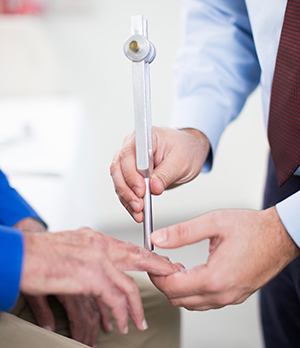Myasthenia Gravis

OHSU’s ALS and Neuromuscular Disease Center team includes experts in diagnosing and treating myasthenia gravis. As an academic health center, OHSU offers the latest treatments while researching ways to improve care. You’ll find:
- An experienced team of specialists who meet with you on the same day for fast diagnosis and treatment.
- A team that will work with you to tailor care to your specific symptoms.
- Health professionals who can help you navigate care and find the resources you need.
Understanding myasthenia gravis
Myasthenia gravis is a disorder of the immune system. It affects voluntary muscles — the muscles you control.
What is myasthenia gravis?
Myasthenia gravis is an autoimmune disease, meaning your immune system mistakenly attacks your body. In this condition, the immune system disrupts messages between your nerves and voluntary muscles.
Normally, nerve signals travel down nerves to meet muscle fibers in spots called neuromuscular junctions. The nerves send a chemical across the junctions to muscle fibers. Receptors on the fibers receive the chemical and tell the muscles to contract.
With myasthenia gravis, the immune system blocks or damages the receptors. The muscles receive fewer signals, cannot fully contract, and weaken. The weakness worsens with activity and gets better with rest.
Who gets myasthenia gravis?
Myasthenia gravis is relatively rare, affecting 36,000 to 60,000 Americans, according to the National Institutes of Health. This diagnosis has become more common in recent years, possibly because doctors are identifying it earlier. New treatments are also helping patients live longer.
Most patients can have a normal life expectancy. There is no cure, but with the right treatment, people can often control symptoms and lead active lives. Sometimes symptoms vanish temporarily or permanently.
Risk factors include:
Gender: Women are more likely to develop myasthenia gravis.
Age: Women who develop the disease are typically younger than 40. Men are typically older than 60.
Related disorders: People who have had one autoimmune disease, such as rheumatoid arthritis, are at greater risk of developing another, such as myasthenia gravis.
What causes myasthenia gravis?
Scientists don’t know exactly what causes myasthenia gravis. Many factors may come into play, including genetic changes. A virus or bacteria might trigger the condition.
Types of myasthenia gravis
- Generalized: Weakness in the torso, arms and legs.
- Ocular: Weakness in the eye muscles.
- Congenital: Present at or shortly after birth.
- Transient neonatal: Develops in infants whose mothers had the disease but vanishes within a few weeks.
Symptoms of myasthenia gravis
Myasthenia gravis affects voluntary muscles in the face, eyes, arms and legs. Symptoms, which may be similar to those of other conditions, can include:
- Drooping eyelids, blurry vision or double vision
- Muscle weakness in the face, neck, arms, hands, fingers or legs
- Problems chewing, swallowing, talking or smiling
- Shortness of breath or difficulty coughing or breathing deeply
- Tiring easily, especially in arm or leg muscles
- Limited facial expressions
Diagnosing myasthenia gravis
Myasthenia gravis can be difficult to diagnose because muscle weakness can be a sign of other conditions. Our specialists have the experience and skills to make an accurate diagnosis and rule out other conditions.

First appointment: We start by asking about your symptoms, reviewing your medical history and doing a physical exam.
Other tests may include:
EMG: You can expect to take an electromyography test, which takes about 30 minutes. An EMG measures electrical activities to tell doctors if there’s a problem with the messages between your nerves and muscles.
Nerve conduction studies: These measure how quickly electrical signals travel along your nerves. During nerve conduction studies, we use small electrodes on the skin to stimulate the nerves, then measure their response.
Blood tests: We use these tests to spot high levels of antibodies — proteins that fight infection. They are present in some patients who have myasthenia gravis.
Other tests: We may suggest imaging scans, such as MRI or CT, to gather detailed pictures of your body. This can help us rule out other conditions.
Treatments for myasthenia gravis
Your care team will work with you to develop a treatment plan to help you live well with myasthenia gravis. Your options may include medication, surgery or treatments to boost your immune system.
Several types of medications can strengthen muscles. Options may include:
- Anticholinesterase medications: These relieve symptoms by slowing the breakdown of acetylcholine, a chemical that helps strengthen muscles and control symptoms.
- Immunosuppressants: These aim to increase muscle strength by stopping the immune system from attacking your nerve-muscle connections.
Intravenous immune globulin, often shortened to IVIG, is an IV infusion of healthy antibodies to strengthen your immune system. These antibodies are delivered through a substance called immunoglobulin, which comes from donor blood.
Each infusion takes two to four hours. Your doctor will most likely recommend infusions every three to four weeks.
Plasmapheresis, or plasma exchange, removes harmful antibodies from the blood and replaces them with healthy plasma (the liquid part of the blood).
The procedure takes one to three hours. You will be connected to a device called an apheresis machine that filters out the antibodies responsible for the condition. The remaining blood is then combined with a plasma substitute and returned to your body.
People with myasthenia gravis often have an abnormal thymus gland, an organ in the chest. Some patients may benefit from thymectomy surgery to remove the gland.
The thymus is part of the immune system and most active in childhood. Scientists have linked it to the production of the antibodies responsible for myasthenia gravis. Removing the thymus may reduce your symptoms. In some cases, symptoms may disappear.
Support services
As part of your treatment at OHSU, you will meet with our team of social workers who can:
- Connect you with resources, such as finding in-home help.
- Answer questions and counsel you and your family.
- Help with financial questions or applications for Medicare or disability benefits.
Clinical trials and research
We offer access to clinical trials to test promising new treatments. For instance, OHSU researchers contributed to studies of the safety and effectiveness of eculizumab, which won approval from the U.S. Food and Drug Administration in 2017. It was the first FDA-approved medication for myasthenia gravis since the 1950s.
Learn more
- Myasthenia Gravis, U.S. National Library of Medicine
- Myasthenia Gravis, National Organization for Rare Disorders
- Myasthenia Gravis, U.S. Department of Health and Human Services
For patients
- Referral: To become a patient, please ask your doctor for a referral.
- Nerve Center referrals: You may also be referred to us by the OHSU Nerve Center, where specialists direct patients to the team best able to treat them.
- Questions: For questions or follow-up appointments, call 503-494-5236.
Location
Parking is free for patients and their visitors.
OHSU ALS and Neuromuscular Disease Center
Center for Health & Healing Building 1, eighth floor
3303 S. Bond Ave.
Portland, OR 97239
Refer a patient
- Refer your patient to OHSU.
- Call 503-494-4567 to seek provider-to-provider advice.
Clinical trials
- Look for an OHSU Brain Institute clinical trial.
- Learn more about current clinical trials for patients with ALS or other neuromuscular disorders by contacting:
Diana Dimitrova, Ph.D.
503-494-7269Research assistants:
Katie Lewis lewiskat@ohsu.edu
Katie Norris norriska@ohsu.edu
Finding relief in a clinical trial

A mother of two finds that she can now walk and work after participating in a Cartesian clinical trial that treated her myasthenia gravis symptoms.